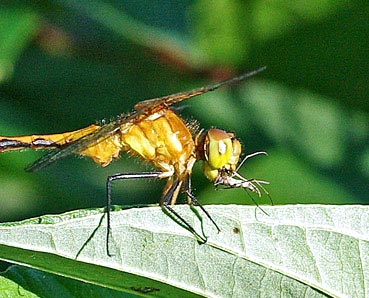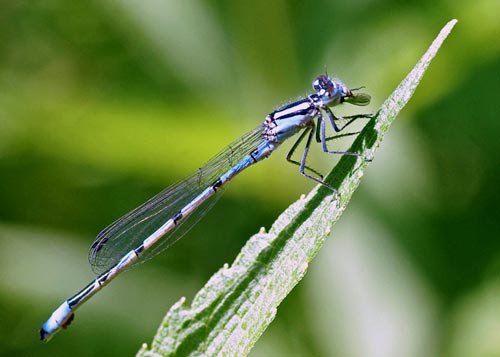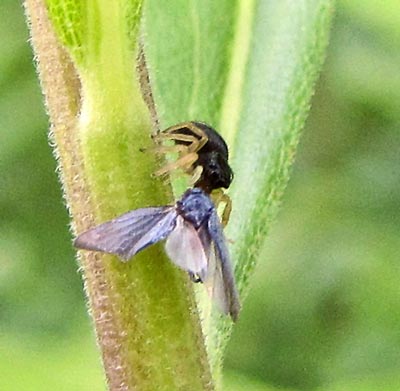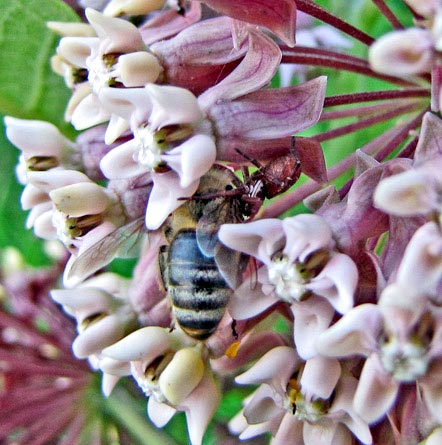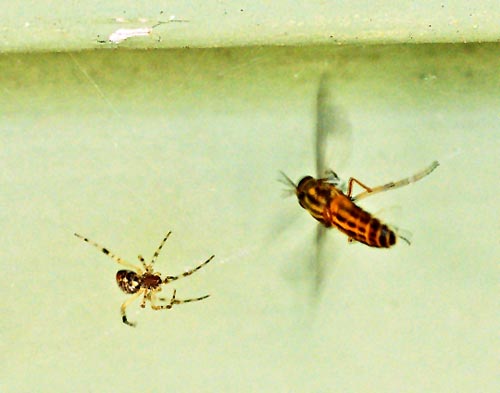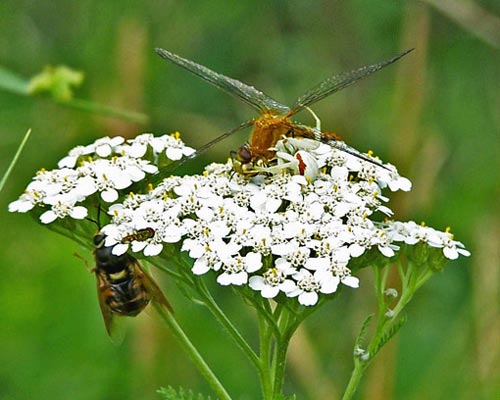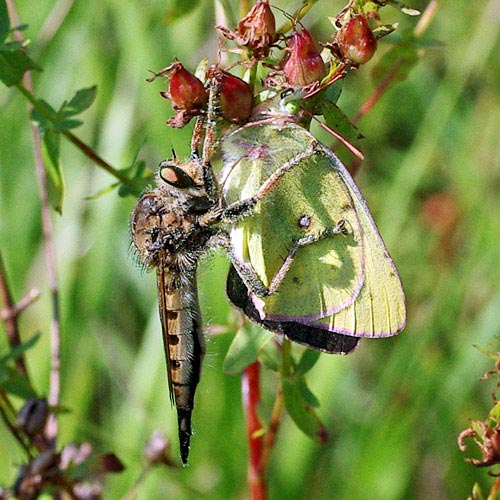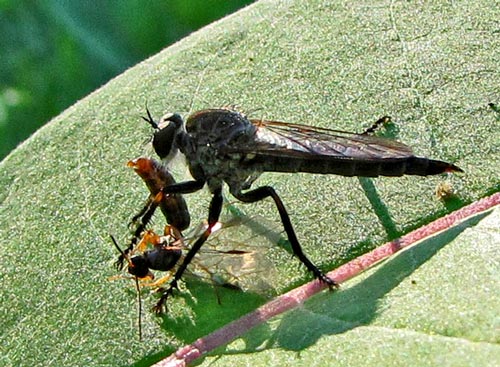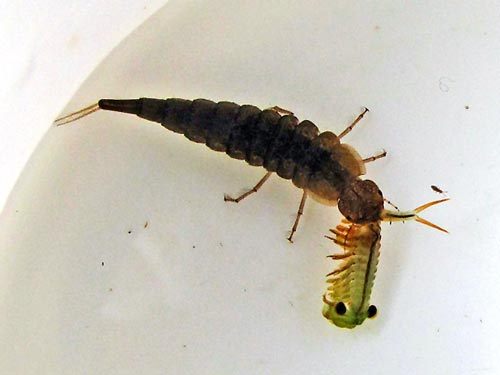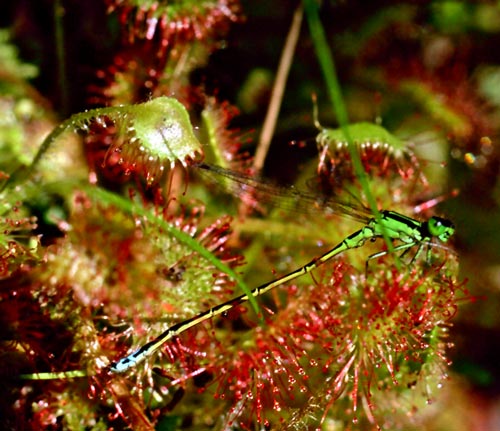Salutations, BugFans,
The BugLady has been a fan of predators since she was old enough to lisp out the word. She likes the cuts of their collective jibs and their matter-of-fact fierceness. To her, the “eat-ers” are far more interesting than the “eat-ees.”
Diagrams of energy pyramids illustrate that it takes lots and lots and lots of herbs (the base of the pyramid) to feed a moderate number of herbivores (primary consumers), which feed lesser numbers of meat-eaters (secondary and tertiary consumers) at its tip. Makes sense—100 seals keep a single Orca swimming, not vice versa. The tiers of the pyramid are known in the ecology trade as trophic levels, and it gets confusing because many organisms hang out on multiple levels of the food web. A coyote is a primary consumer when it eats windfall apples, a secondary consumer when it eats a plant eater like a rabbit, and a tertiary consumer if it devours a (meat-eating) snake. In addition, “extended” definitions of predation (a feeding activity that results in the death of the prey) may include parasitism, parasitoidism, and even some grazing.
While going about their business, many insect carnivores (inadvertently) act as biological controls on other invertebrates that compete with or otherwise annoy us. The predators themselves are not burdened by fine distinctions between “your good bugs and your bad bugs” (the terminology of a good ol’ boy Texas exterminator, who went on to assure the BugLady that the summer camp’s dishes could stay in the cupboard during pesticide application and need not be washed before use). Praying mantises eat honeybees as readily as they do deer flies.
Occasionally, in the name of controlling insect “pests” we play ecological Russian Roulette by importing alien predators to specialize in alien pests. Some stay “on task,” but others drift disastrously off target, devastating non-pest species (and that’s a different soapbox). Predators eat to survive; they survive to reproduce; and it’s no more complicated than that (despite the sinister music heard on Nature shows as the snake stalks the cute little mouse).
Both the hunters and the hunted bear an astonishing array of adaptations that allow the prey to hide-flee-fend off-escape its predator and the predator to stalk-grab-subdue-gulp-pierce-chew-slurp its prey.
The BugLady searches for predators by looking for their prey—insects that are too still. Take a moment, then, to celebrate some of the carnivores that perpetrate minor mayhem all around us, every day:
Dragonfly
Dragonflies, generally those of the Meadowhawk tribe, often accompany the BugLady on her perambulations in Bog and in field. Her aerial companions work the clouds of mosquitoes and deer flies that circle her head. Their compound eyes—banks of wedge-shaped, simple eyes, each with its own optic nerve—allow them to spot flying insects. This one has a mosquito hanging out of its mouth.
Bluet Damselfly
This bluet damselfly also has tiny wings sticking out of its mouth, but the picture is a “two-fer.” At the end of its abdomen are three reddish spheres—probably water mites. The two species got together underwater while the damselfly was still a naiad. The mites, in their parasitic stage, became airborne with the adult damselfly and will ride along like tiny ticks until its time for them to drop off and move to a different life stage.
Yellow-legged Spider
The BugLady was stalking something small with her camera and found something even smaller—a yellow-legged spider with a plant hopper that measures about a centimeter. In plant stem thickets, many spiders employ stalking and ambush instead of webs.
Spider Holding the Honeybee
Can you see the spider that’s holding the honeybee behind the milkweed flowers The BugLady once read that our fields may host a million spiders per acre.
Slender Spider
A slender spider moves in to immobilize her considerably bulkier prey, an actively-buzzing deer fly that spins on one sticky strand of the web that she spun near a porch light. Her web is her “equalizer.”
Crab Spider
A well-camouflaged crab spider sits to the right of her dragonfly prey on a bank of yarrow flowers. A second predator, unseen below the flowers, dangles a soldier fly.
Robber Fly
The BugLady loves the large, noisy, competent robber flies that harvest the bounty of the fields. Like dragonflies and damselflies, they may hunt from perches, and like dragonflies and damselflies, the spines on their front legs help them secure their prey.
Another robber fly finishes off an ichneumon wasp. Adult ichneumons drink nectar and water, but as larvae, they are parasitoids, eating the insides or outsides of their living host. Adult robber flies suck out their victim’s juices and discard the empties.
Predaceous Diving Beetle Larva
Mini-“Jaws,” a larva of the predaceous diving beetle with the well-deserved nickname “water tiger,” pursues prey almost as large as it is. The small dot by the fairy shrimp’s tail is an aquatic springtail, a future meal for the water tiger.
Sundew
Are plants predators? This damselfly, caught firmly by the sundew, would have an opinion. The BugLady, who loves carnivorous plants but loves damselflies even more, released it.
Have you hugged a predator today?
The Bug Lady
